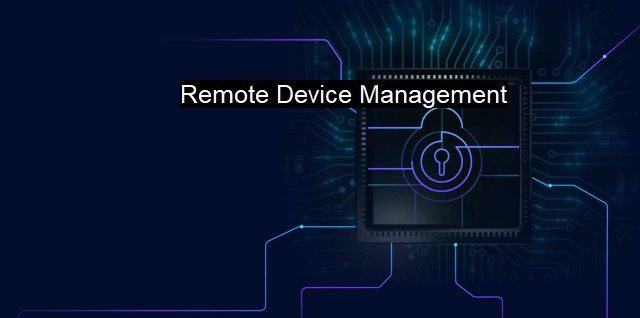What is Remote Device Management?
The Importance of Remote Device Management (RDM) in Modern Cybersecurity: Securing and Monitoring Devices From a Centralized Location to Reduce Cyber Threats and Protect Sensitive Data
Remote device management (RDM) is an essential component of modern cybersecurity protocols. RDM involves managing and monitoring remote devices, such as servers, desktops, laptops, tablets, and even mobile devices such as smartphones, from a centralized location using specialized software and protocols. RDM helps ensure that devices accessible from remote locations are protected against unauthorized access, malware attacks, and other security vulnerabilities.Remote device management has become more critical in recent years because of the increasing number of remote workers and the widespread use of mobile and internet-connected devices. With more people working from home and accessing confidential data from remote digital systems, securing these systems has become more complicated. Businesses, government agencies, healthcare facilities, and other organizations also require digital systems and data protections that prioritize maintaining data security and compliance with industry best practices. Ensuring that remote devices are safe and secure helps to minimize cyber threats, data loss, and reputational damage.
RDM solutions help IT teams manage remote devices and enforce security policies without the need to be physically present at remote sites. IT administrators can monitor, manage, and troubleshoot individual devices remotely, with complete control over vital features like software updates, firewall settings, and other risk mitigation features. This practice helps significantly reduce the administrative overhead of supporting remote devices and improves overall cybersecurity posture.
Remote management solutions use state-of-the-art techniques and tools such as Virtual Private Networks (VPNs) and specialized software to identify and monitor the devices themselves. Once identified, administrators can verify their physical and network connections and configure device security settings according to organizational best practices. Administrators can monitor and report on devices in real-time, identifying and alerting them to problems, and ensuring action is taken as quickly as possible, further enabling their ability to act with confidence mitigate risks around the clock.
Antivirus programs are essential components of remote device management solutions. Viruses, trojan horses, and other malicious software can be catastrophic to a digital system and requiring line items that always need to be protected effectively against security risks. Antivirus tools typically come with proactive scanning features, allowing administrators to verify system integrity by scanning system files for malware, ransomware, and other types of threats potentially including exploits that pose exploits onto entries in gateways and otherwise gain remote access. Integrated risk controls also allow reaction time upon notified entry via anti-phishing functionality which monitored by the antivirus application raises a risk level notification allowing real-time management through RDM from any remote area.
Advanced remote device management and anti-malware solutions leverage artificial intelligence (AI) and machine learning technologies. These systems automatically monitor and learn individual device's behavior to take swift action to address security issues proactively, efficiently. Increasing automation, largely within global business contexts reduces dependency on individual actions as the technologies are experts at resolving immediate problems and ensuring high visibility and dynamic visual reporting tracking external threats in real-time.
RDM is essential in cybersecurity, anti-virus containment/response mechanisms integral components of such protocols. Remote device management enables effortless management of the constant rise of off-premise infrastructure and the growing endpoint attack threats incurred on technological systems. It helps secure remote working on and accessing sensitive data by ensuring that all remote management tools comply with reporting, action depth, speed, and contextual adaptation necessary to secure the sectors. As cybersecurity threats grow more significant, Remote Device Management continues to be an important weapon in business and the global community's cybersecurity arsenal. Successful organizations now invest vast amounts of time and human capital principles such as Otago compliance when addressing this risk head-on.

Remote Device Management FAQs
What is remote device management?
Remote device management is the process of managing and controlling devices remotely, without physical access to them.Why is remote device management important for cybersecurity?
Remote device management is important for cybersecurity because it allows IT administrators to monitor and manage devices from a centralized location, making it easier to detect and respond to security threats.What are some common features of remote device management software?
Common features of remote device management software include remote access and control, hardware and software inventory management, patch management, security and antivirus management, and reporting and analytics tools.What are some best practices for remote device management?
Some best practices for remote device management include implementing strong security protocols, using multi-factor authentication, encrypting data in transit and at rest, regularly updating and patching devices, and monitoring devices for suspicious activity.| | A | | | B | | | C | | | D | | | E | | | F | | | G | | | H | | | I | | | J | | | K | | | L | | | M | |
| | N | | | O | | | P | | | Q | | | R | | | S | | | T | | | U | | | V | | | W | | | X | | | Y | | | Z | |
| | 1 | | | 2 | | | 3 | | | 4 | | | 7 | | | 8 | | |||||||